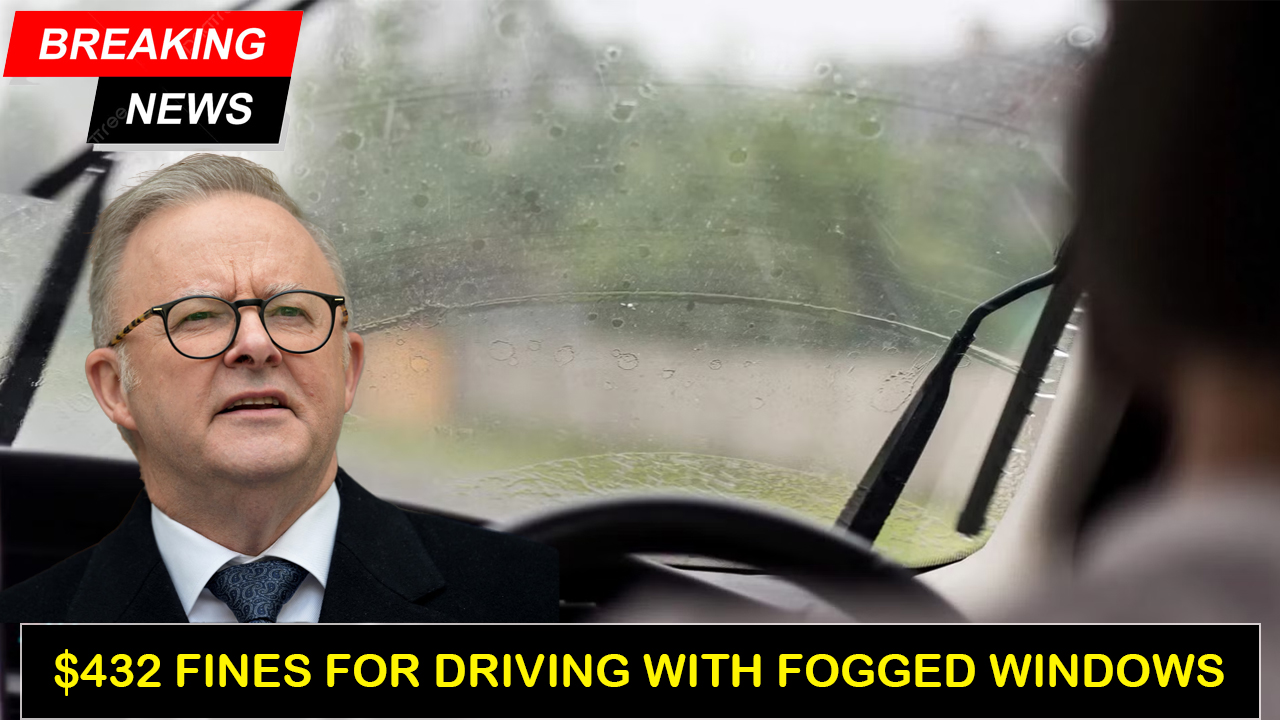Driving in Australia has always come with its fair share of rules, from speed limits to seatbelt checks, but here’s one that might surprise you: fogged windows could now land you a $432 fine. Yes, you read that right. Something as simple as a misty windscreen on a cold morning could actually hurt your wallet.
Now, before you shake your head and say, “Really? Isn’t that a bit much?” let’s dig into why this rule exists, how it’s being enforced, and what you can do to avoid it. Because, let’s be honest, no one wants to hand over $432 just because they didn’t clear up their glass properly.
Why Fogged Windows Are a Bigger Deal Than You Think
At first glance, fogged windows don’t seem like a huge issue. We’ve all been there—jumping into the car early in the morning or after a sudden rain, only to find the inside of the windscreen coated in mist. You probably think, “It’ll clear up as I drive.”
But here’s the catch: driving with obstructed visibility is a major safety hazard. Roads in Australia are already risky with unexpected wildlife, sharp turns, and busy intersections. Add fogged-up windows into the mix, and suddenly you’ve got blind spots that can put you, your passengers, and other road users in danger.
Authorities argue that poor visibility is no different from driving with cracked windscreens, mud on your mirrors, or even texting at the wheel—all of which compromise road safety.
The Fine Details: What You’ll Pay
So, how much could this slip-up cost you? Let’s break it down clearly:
| Offence | Fine (AUD) | Demerit Points | Notes |
|---|---|---|---|
| Driving with fogged/obstructed windows | $432 | 3 points | Applies across most states and territories |
| Driving with dirty/muddy windows reducing visibility | $432 | 3 points | Considered the same as fogged windows |
| Failure to ensure clear mirrors | $432 | 3 points | Covers both side and rear-view mirrors |
In other words, whether your windows are fogged, dirty, or smeared with anything that blocks your line of sight, you’re looking at a $432 hit and three demerit points. That’s not just a warning slap on the wrist—it’s a proper penalty.
How This Rule Is Being Enforced
To be fair, this isn’t a brand-new idea. Road safety laws have always included clauses about “maintaining clear visibility.” What’s changed is the strictness of enforcement. Police officers are now actively pulling drivers over if they notice fogged or dirty windscreens that block visibility.
Think of it this way: if a speed camera can catch you going a few km/h over, it’s no surprise officers are on the lookout for something as obvious as a misty windshield.
And honestly, if you’ve ever tried driving while constantly wiping your window with your sleeve, you know how distracting (and dangerous) it can be.
Why Authorities Are Cracking Down
So why the sudden seriousness? According to road safety experts, driver distraction and reduced visibility remain leading causes of accidents. It’s not always speeding or drunk driving—it’s often the small things, like not noticing a pedestrian crossing the street because your windscreen is hazy.
Officials argue that the fine acts as a deterrent. If the fear of losing $432 doesn’t push drivers to flick on the demister or wait a few extra minutes before driving off, what will?
Practical Tips to Avoid Getting Fined
Alright, so you know the fine exists and you don’t want to pay it. What can you do? Luckily, preventing foggy windows isn’t rocket science. Here are a few quick fixes:
-
Use Your Car’s Demister Properly – Most modern cars have front and rear demister buttons. Turn them on before you drive, not after you’ve already hit the road.
-
Air Conditioning Trick – Running your AC helps pull moisture out of the air inside the cabin. Even in winter, it’s worth using.
-
Keep Windows Clean – Dirt and dust on your windscreen make condensation worse. Regular cleaning helps fog clear faster.
-
Crack a Window – A tiny gap can balance the temperature and humidity levels, reducing fog build-up.
-
Anti-Fog Sprays – Available at auto stores, these sprays can be applied to your glass to keep condensation away.
Taking just two or three minutes before driving can save you hundreds of dollars—and potentially save lives.
The Bigger Picture
To be fair, some drivers might feel this fine is excessive. After all, not everyone has the patience to sit in their driveway for five minutes while the car warms up. On the flip side, though, if you look at it from a safety perspective, the rule makes sense. Roads are shared spaces, and your small inconvenience could be the difference between a safe trip and a serious accident.
In many ways, this law highlights a broader trend: Australian authorities are increasingly focusing on preventive safety measures. Instead of only targeting reckless speeding or dangerous overtaking, they’re now zooming in on everyday habits that can quietly cause big problems.
Final Thoughts
So, here’s the bottom line: Driving with fogged windows in Australia can now cost you $432 and three demerit points. What feels like a minor inconvenience is being treated with the same seriousness as other visibility-related offences—and honestly, it’s hard to argue against the logic.
Sure, it might feel frustrating to wait for your windscreen to clear up, but ask yourself—would you rather spend a few extra minutes with the heater on or risk a hefty fine (and your safety) on the road?
Sometimes the simplest habits, like making sure your glass is clear, can make all the difference. And in this case, it’ll keep your bank account a little healthier too.




